Queen Elizabeth II funeral updates: Queen laid to rest alongside husband in private ceremony
The U.K. and much of the world spent Monday mourning Queen Elizabeth II, who was celebrated at a funeral at Westminster Abbey and brought to her final place of rest, St. George's Chapel.
With the funeral concluded, and a private burial service held at 7:30 p.m. local time, a period of Royal Mourning is set to last for the next seven days, according to the wishes of the new king.
While the mourning period continues for the royal family, the transition of power has already occurred. The queen's eldest son, Charles Philip Arthur George Windsor, 73, is now King Charles III of the United Kingdom of Great Britain and Northern Ireland. But the date for the formal coronation ceremony for the new king has not yet been announced.
Shortly after the queen was laid to rest, the royal family's official Twitter account shared a new photo of Queen Elizabeth II climbing a hill with a walking stick in one hand and a coat draped over the other. She looks off in the distance, wearing sunglasses and a head scarf, as lush greenery fills the landscape behind her.
Along with the photo, the account shared a quote from William Shakespeare's "Hamlet": "May flights of Angels sing thee to thy rest."
‘May flights of Angels sing thee to thy rest.’
In loving memory of Her Majesty The Queen.
1926 - 2022 pic.twitter.com/byh5uVNDLq— The Royal Family (@RoyalFamily) September 19, 2022
Queen laid to rest alongside husband, Prince Philip
The queen was laid to rest in an intimate ceremony away from cameras in Windsor, where she was reunited with her husband and her parents.
Charles and senior royal family members gathered late Monday for the private interment ceremony at St. George’s Chapel, a gothic church on the grounds of Windsor Castle that has hosted royal weddings, christenings and burials since the 15th century.
In contrast to the pomp and pageantry of her grand state funeral, royal officials said the queen's internment was a “deeply personal family occasion.” They said the queen was interred together with Prince Philip’s remains at the King George VI memorial chapel, an annex within St. George’s.
When Philip, the queen's husband of 73 years, died last year, his coffin had been placed in a different part of St. George’s Chapel, ready to be moved to the memorial chapel to join the queen when she died.
Elizabeth II’s parents, King George VI and Queen Elizabeth, were also interred there along with the ashes of Princess Margaret, the late monarch’s younger sister who died in 2002.
St. George's is the resting place of 10 former British monarchs, including Henry VIII and the beheaded Charles I. It is also the home of the Order of the Garter, an ancient order of chivalry founded by King Edward III in 1348.
Speaking ill of the dead?: We can't ignore Queen Elizabeth's complicated legacy
When will King Charles' coronation take place?
Charles will be crowned probably within the year; the ancient ritual of the coronation requires advance planning, although a lot of that has already been done. But there hasn't been a coronation since June 1953 when Elizabeth was crowned, following the death of her father King George VI. Queen Elizabeth II was 25 when she took the throne.
Most people in the U.K. have never lived through such a momentous event. But there's little puzzlement in the royal palaces, in Parliament or the British government, and almost certainly none in Charles' mind.
Opinion: King Charles III must do better than his mother on colonialism and reparations. Will he?
What happens next has been carefully planned out for decades, based on combining ancient funeral and coronation traditions with practical measures to cope with such modern realities as instant communication, traffic control, social media and the vestiges of a pandemic.
The queen's funeral was expected to draw millions of viewers
The state funeral, expected to be the biggest gathering of world leaders in years, drew millions of people to the streets of London and likely billions more to their TVs and computer screens. The funeral and events surrounding it were designed to help unite the royal family and divided subjects while helping ensure the monarchy survives another century.
London’s mayor’s office said up to two million people were expected to line the streets as members of the royal family and hundreds of foreign dignitaries and heads of state descended on Westminster Abbey. More than 10,000 police officers were on patrol in London with reinforcements supplied from all of Britain’s 43 police forces, authorities said.
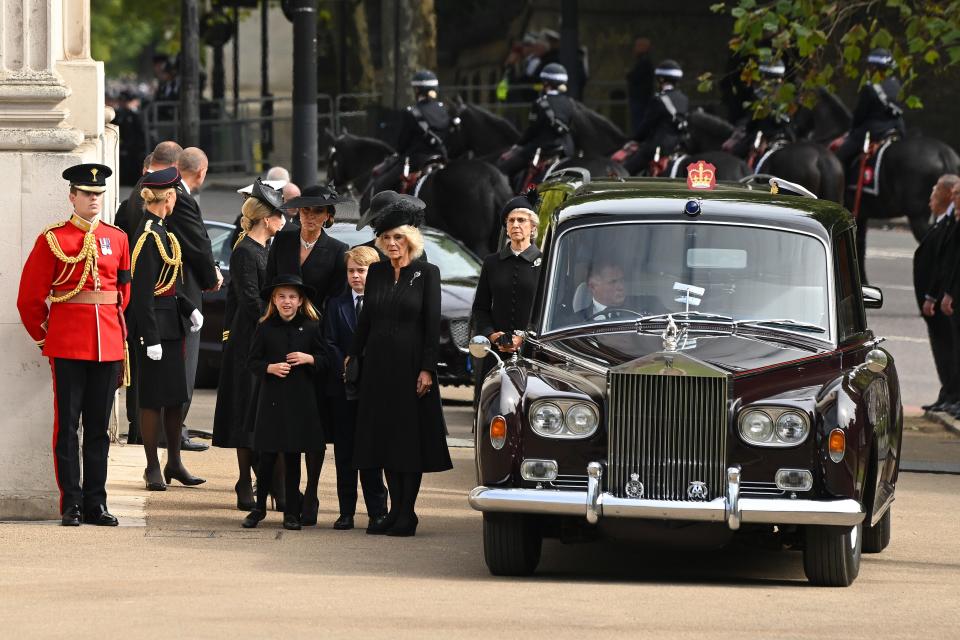
The royal family: A look at the British royal family tree, spanning four generations

Read more about what to expect from the reign of King Charles III: What kind of sovereign will he be? Not like his mother
Celebrities pay their respects to the queen
Some celebrities posted on social media to pay their respects to the late queen, while others attended Monday’s events to do the same.
David Beckham, who waited in the queue like thousands of others to visit the queen’s coffin as it laid in state last week, posted a photo on Instagram.
“Our Queen is home.. Today we said a final farewell to Her Majesty The Queen,” he wrote in the caption.
Sandra Oh attended the funeral at Westminster Abbey, posting several photos on Instagram, featuring the actress wearing mourning colors.
And Elton John posted photos, too, remembering some moments he shared with the queen and noting she will be "sorely missed."
“My own memories of her are filled with joy and admiration," he wrote. The Queen honoured me with a CBE, a knighthood and the Companion of Honour. I was lucky enough to perform at three of her Jubilees. They were always joyous and humbling experiences. But it was the moments out of the public eye that I will most fondly remember her for."
What is the committal service at Windsor Castle?
The queen headed to her final resting place in Windsor Castle where a committal service took place before she was lowered into the Royal Vault.
The committal service was conducted by the dean of Windsor, David Connor. Events include prayer and a choir performance at St George's chapel. Nearly 800 people were expected to attend, including royal family members, and the hymn, "All My Hope on God is Founded," was performed.
While the procession took place, the Imperial State Crown sat atop the queen’s coffin along with her scepter and orb.
During the committal service, the crown, scepter and orb were removed from the top of the coffin. The items were placed on an altar at St. George’s Chapel, and marked the final separation of the late queen from her crown.
The “Wand of Office” was broken by the Lord Chamberlain, Lord Andrew Parker. The breaking of the wand is a tradition in a sovereign’s funeral, according to The Independent, and hasn’t been seen since King George VI died in 1952.
The new king stood by quietly during the moments of farewell and appeared somber and a bit teary-eyed before his mother’s coffin was lowered into the vault.
Past tears: Did Queen Elizabeth cry at Prince Philip's funeral? How she manages to stay stoic
British Prime Minister Liz Truss arrives at St George's chapel
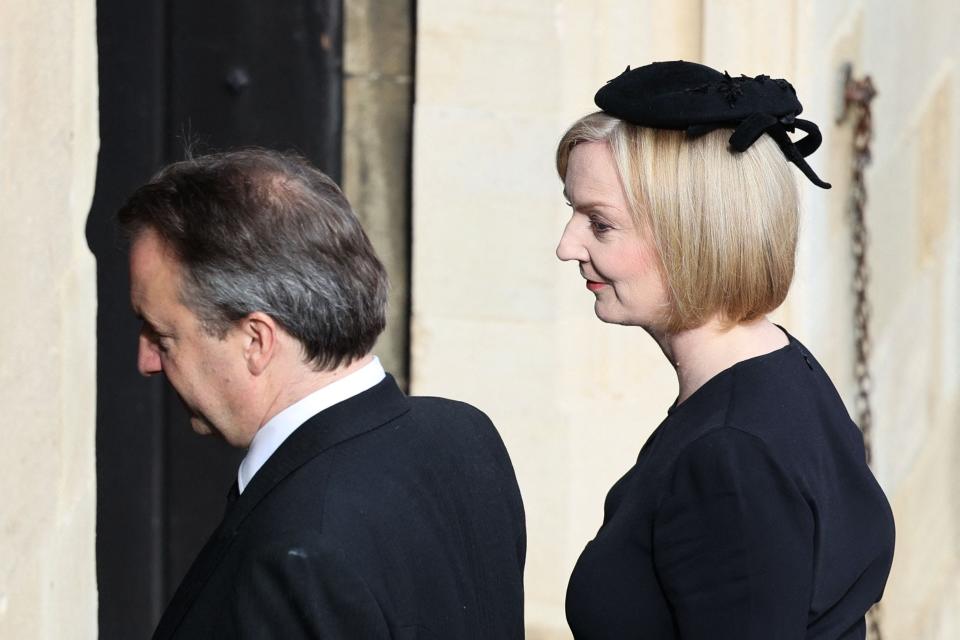
British Prime Minister Liz Truss and husband Hugh O'Leary attended the queen's state funeral. They were also among early arrivals to St George's chapel for the committal service.
At the state funeral, Truss read a prayer from Bible’s John 14: 1-9.
Princess Kate, daughter Princess Charlotte honor the queen with poignant accessories

Mother and daughter duo Princess Kate and Princess Charlotte, who attended the state funeral, both wore simple black dresses topped with black overcoats, paired with black tights and black shoes. But their jewelry choices paid tribute to a beloved matriarch.
Princess Charlotte wore a dainty brooch on her coat in the shape of a horseshoe, a tribute to the queen, her great-grandmother, who had a lifelong passion for horses. The queen often attended races and was also a successful owner and breeder.
Princess Kate, the wife of Prince William, wore two pieces of jewelry that once belonged to her grandmother-in-law. She wore Bahrain Pearl Drop Earrings and a four-strand pearl choker necklace, both from the queen's collection, People reported.
Funeral attire: Princess Kate, daughter Charlotte honor Queen Elizabeth with sweet details
Royals escort the queen's casket to Wellington Arch, Windsor Castle
Following the funeral, the coffin – accompanied by units of the armed forces in dress uniforms and members of her family – was carried through the capital’s streets.
At Wellington Arch near Hyde Park, it was placed in a hearse and driven to Windsor Castle – where Elizabeth spent much of her time – for another procession before a committal service in St George’s Chapel. She will be laid to rest with her late husband, Prince Philip, at a private family service.
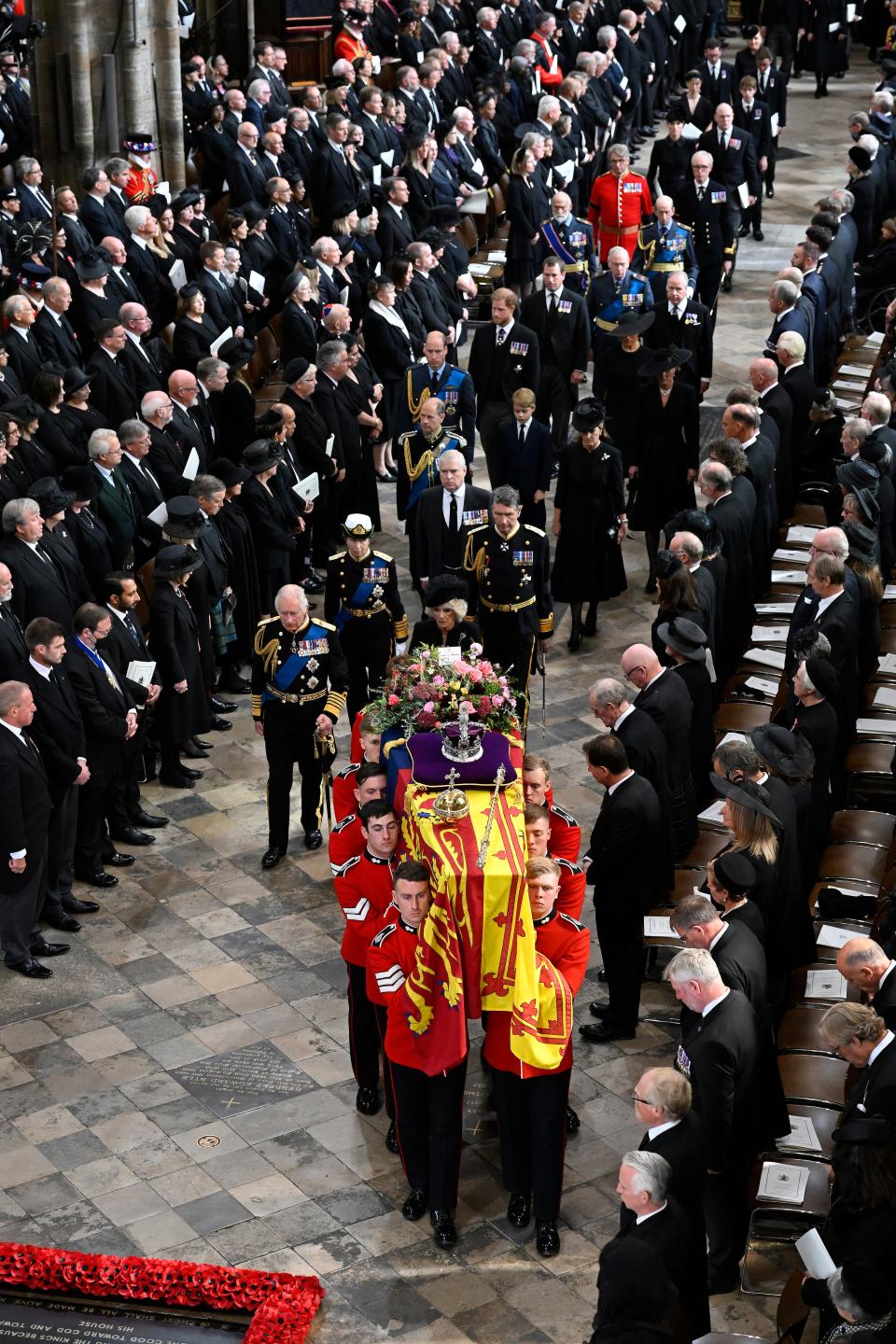
What is the hearse the queen is in?
The queen’s coffin was moved from the gun carriage to the royal hearse at Wellington Arch as it was taken to Windsor. The hearse drove 25 miles west of London to Windsor Castle and St George's Chapel, a mini-cathedral that seats 800 and is often used for royal weddings. It's where Prince Harry and Duchess Meghan were married in 2018.
At Windsor, the state hearse traveled in procession to St George’s Chapel via the Long Walk. Once inside, a committal service began at 4 p.m. local time, 11 a.m. EDT.
The glass-walled hearse allows the queen’s coffin to be viewed – and it is lit up when it is dark out.
Funeral program: What happened at queen's funeral
The funeral concluded just after noon, local time. The pall bearers escorted the queen's coffin onto the gun carriage.
The queen will be buried in a special chapel beneath the floor of St George's with her parents, sister Princess Margaret, and husband, Philip.
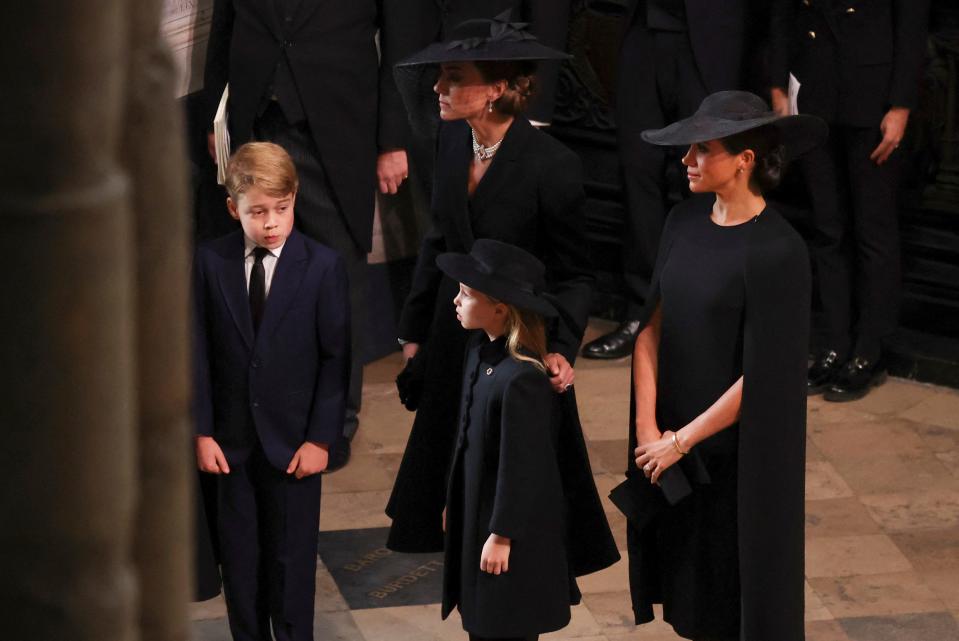
The program also included:
Patricia Scotland Commonwealth Secretary-General read a lesson from Corinthians 15 as a tribute to the queen’s life of dedication to service and the nation.
A sermon by the Archbishop of Canterbury
Choirs sang the Anthem, taken from "Songs of Farewell" by Hubert Parry, a favorite of King Charles'.
A short anthem, composed by Ralph Vaughan Williams for the queen’s coronation in 1953, presenting a reflective moment in the service.
The third hymn, "Love Divine, All Loves Excelling" is a Welsh tune, and was sung at the wedding of The Prince and Princess of Wales at Westminster Abbey in 2011. The arrangement is by James O’Donnell, a former organist at the Abbey.
The Archbishop gave the commendation over the queen’s coffin. The commendation will include the familiar line, "Go Forth, O Christian Soul, From This World," which is often heard during funerals.
The choirs sang a new anthem, composed for the service by Sir James McMillan. The words are taken from Romans 8, which leads with the hopeful, confident line, "Who shall separate us from the love of Christ?"
The dean pronounced the blessing from the altar, and the congregation will remain standing for the last post, which will be sounded by the state trumpeters of the household cavalry.
This was followed by two minutes’ silence, to be observed across the United Kingdom.
The trumpeters then sounded the reveille, before the national anthem was sung.
The sovereign’s piper played the traditional lament, ‘Sleep, dearie, sleep.’
At the conclusion of the lament, at noon local time (7 a.m. ET), the pall bearers entered and moved the queen’s coffin to the state gun carriage.
Charles writes note to the queen tucked in funeral wreath atop coffin
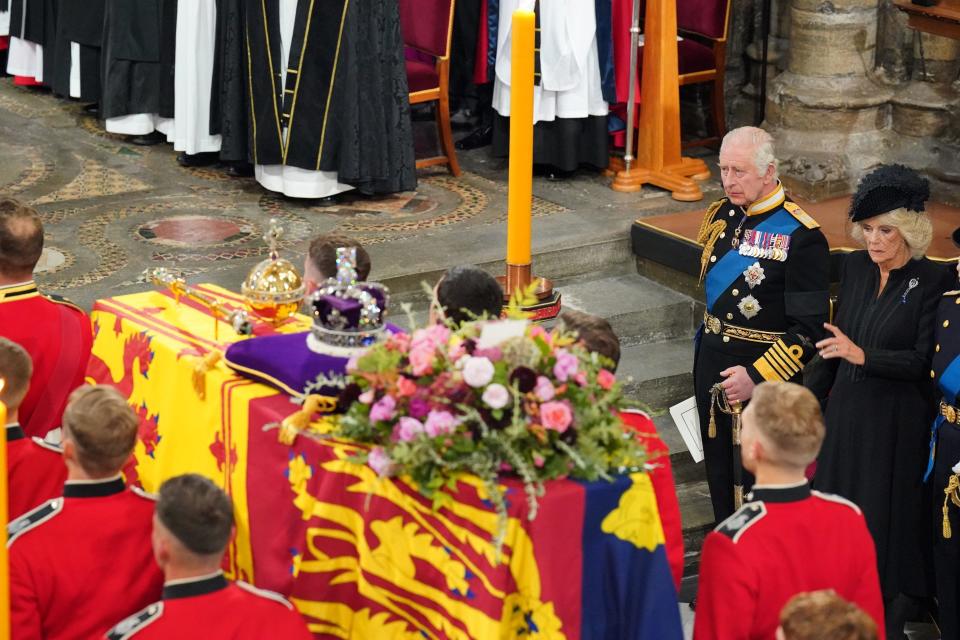
The funeral wreath on the queen's coffin was anything but funereal – it was a massive assembling of color and symbolism topped with a note from Charles. "In loving and devoted memory. Charles R," it read.
"Charles R" is the monarch’s official signature, with R being Latin for "Rex" or king. (Elizabeth’s signature was Elizabeth R for "Regina," Latin for queen.)
The sight of that note immediately evoked memories of the note that sat on Princess Diana’s coffin during her funeral procession to Westminster Abbey in 1997. It was from her sons and signed "Mummy."
According to Buckingham Palace’s notes on the funeral, the queen’s wreath included, at the king’s request, flowers and foliage cut from the gardens of Buckingham Palace, Clarence House and the king’s private home Highgrove House.
The foliage was chosen for its symbolism: Rosemary for remembrance. Myrtle for the ancient symbol of a happy marriage, and cut from a plant grown from a sprig of myrtle in the queen’s 1947 wedding bouquet. English oak symbolizes the strength of love.
Also included are scented pelargoniums, garden roses, autumnal hydrangea, sedum, dahlias, and scabious, in shades of gold, pink and deep burgundy, with touches of white to reflect the Royal Standard on which it sits.
And at the request of the king, a longtime environmentalist, the wreath is made in a sustainable way, formed in a nest of English moss and oak branches and without the use of floral foam.
Who attended the queen’s funeral?
The guest list for the funeral of Queen Elizabeth II amounted to hundreds of people, a mix of members of the British royal family, foreign royals (many of them relatives of the queen), domestic and foreign government leaders, including President Joe Biden and first lady Jill Biden, British religious and military leaders, members of the royal households, and scores of ordinary people, from the National Health Service, for instance, who were invited to mark their service to the nation.
The top British royals:
King Charles III
Camilla, Queen Consort
Princess Anne Princess Royal, Vice Adm. Sir Tim Laurence
Prince Andrew Duke of York
Prince Edward Earl of Wessex, Sophie Countess of Wessex
Prince William, Prince of Wales, Catherine, Princess of Wales
Prince George of Wales
Prince Charlotte of Wales
Prince Harry, Duke of Sussex, Meghan, Duchess of Sussex
Earl of Snowdon
Peter Phillips
Also there are some two dozen other members of the queen’s family, including descendants of her mother’s Scottish family. All eight of her grandchildren are there and some of the older 12 great-grandchildren, including the new second and third in line in the succession, Prince George of Wales, 9, and Princess Charlotte of Wales, 7.
Many of the foreign royals who attended also are related to the British royal family through descent from Queen Victoria, sometimes known as the "grandmother" of Europe in the 19th century. The monarchs of Norway, Denmark, Sweden, the Netherlands, Belgium and Spain are there. Also, Japan’s Emperor Naruhito and Empress Masako, making their first overseas trip since assuming the throne of Japan in 2019.
The Bidens top the foreign leaders list, which also includes France’s President Emmanuel Macron, Germany’s President Frank-Walter Steinmeier and Ireland’s President Michael Higgins. Also there: Ursula von der Leyen, representing the European Union that Britain quit amid many recriminations in 2016. Prime Minister of New Zealand Jacinda Ardern, Australian Prime Minister Anthony Albanese and Canadian Prime Minister Justin Trudeau also are there, representing three of the major Commonwealth nations over which the queen also reigned.
Queen Elizabeth II's funeral: See King Charles III, Prince Harry, all royals who attended
Is Prince Harry at the funeral? Harry wore military medals, but not his uniform
Prince Harry and his wife, Meghan, Duchess of Sussex, were visiting the U.K. from their home in California to promote several causes they are involved with when the queen died.
At Monday's funeral, Harry wore his military medals but not his uniform. He wore the uniform during a vigil on Saturday with Queen Elizabeth's grandchildren.

Royal experts have explained that only working members of the royal family will wear the military uniform for the five events during the late monarch's period of mourning and state funeral.
Harry walked in to Westminster Abbey alongside his brother, Prince William. But during the service, Harry and Meghan sat in the second row behind his father, while William, Princess Kate and their children Prince George and Princess Charlotte sat across the aisle in the first row.
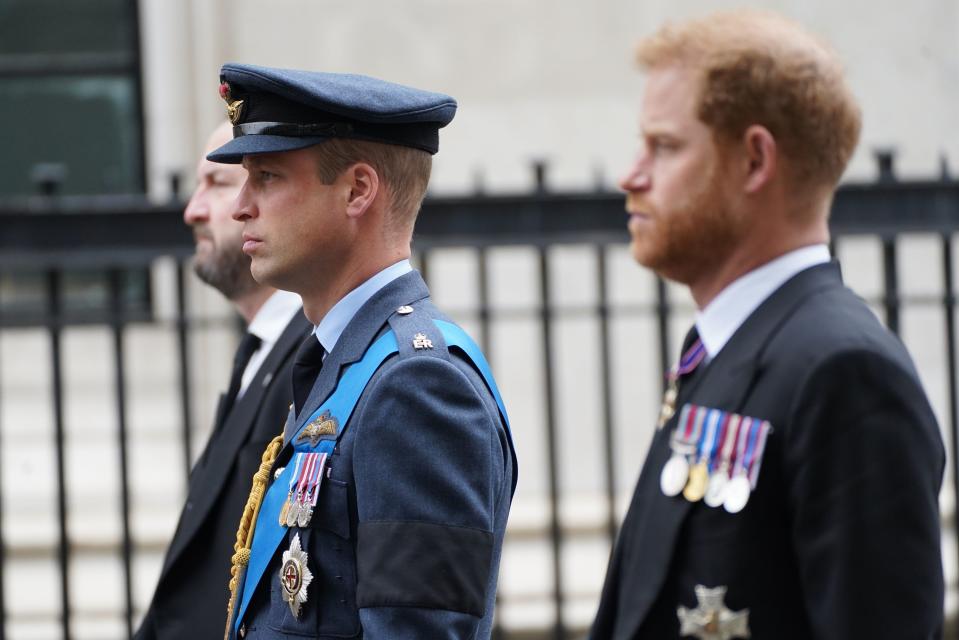
Is Sarah 'Fergie' Ferguson at the funeral?

Sarah Ferguson, affectionately known as Fergie, attended the state funeral for the queen Monday. The Duchess of York, 62, has remained close with the royals despite her divorce from Prince Andrew in 1996. The former pair share daughters Princess Beatrice, 34, and Princess Eugenie, 32, who were also in attendance.
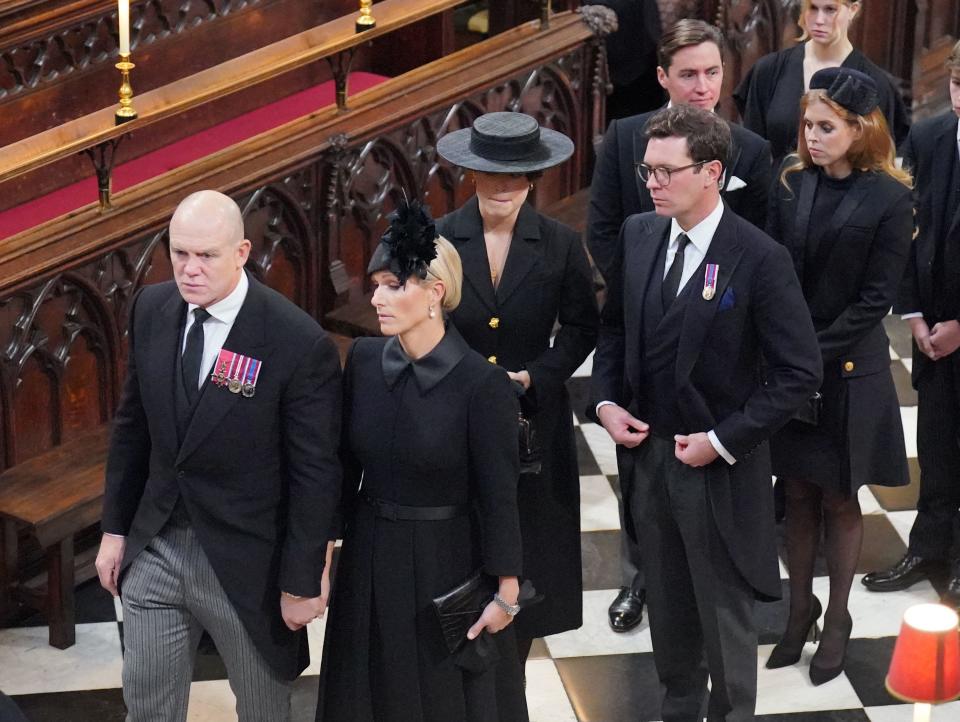
Following the queen's death, Ferguson wrote in a tribute on Twitter that "she was was the most incredible mother-in-law and friend."
"I will always be grateful to her for the generosity she showed me in remaining close to me even after my divorce," the Duchess of York added. "I will miss her more than words can express."
State funeral at Westminster Abbey
The queen's casket entered Westminster Abbey around 11 a.m. local time Monday. The choir of St. George's Chapel sang The Sentences as the queen's coffin procession, including King Charles, Prince William, Princess Kate, Prince Harry, Meghan, Duchess of Sussex, Prince George, Prince Charlotte, Princess Anne, Prince Andrew and Prince Edward, followed the coffin into the abbey.
David Hoyle, Dean of Westminster, opened the service before attendees joined together to sing The Hymn, "The Day Thou Gavest, Lord, is Ended."
During the funeral, speakers included Most Rev. Justin Welby, Archbishop of Canterbury; Rev. Mark Birch, Minor Canon and Precentor; Patricia Scotland, Commonwealth secretary-general; Shermara Fletcher, principal officer for Pentecostal and Charismatic Relations, Churches Together in England; and Rt. Rev. Dame Sarah Mullally. As the funeral concluded, the choir sang "God Save the King."

Funeral music: Hymns sung at queen's funeral
The music during the funeral will be sung by the choir of the Westminster Abbey and included The Sentences, written by William Croft, whose Sentences have been used since the mid 1500s, and at every State Funeral since the early 18th century.
The choir of St George's Chapel sang The Sentences during the procession as the casket entered. The choir of Westminster Abbey began the funeral service in song, later joining with the choir of the Chapel Royal for a rendition of "Like as the Heart." The funeral's attendees sang "The Day Thou Gavest, Lord, is Ended."
The choir also sang "The Lord’s My Shepherd," which also was heard at the Wedding of The Queen and The Duke of Edinburgh in 1947. The choir sang "God Save the King," featuring different lyrics from what many have known for decades as "God Save the Queen," as the funeral concluded.
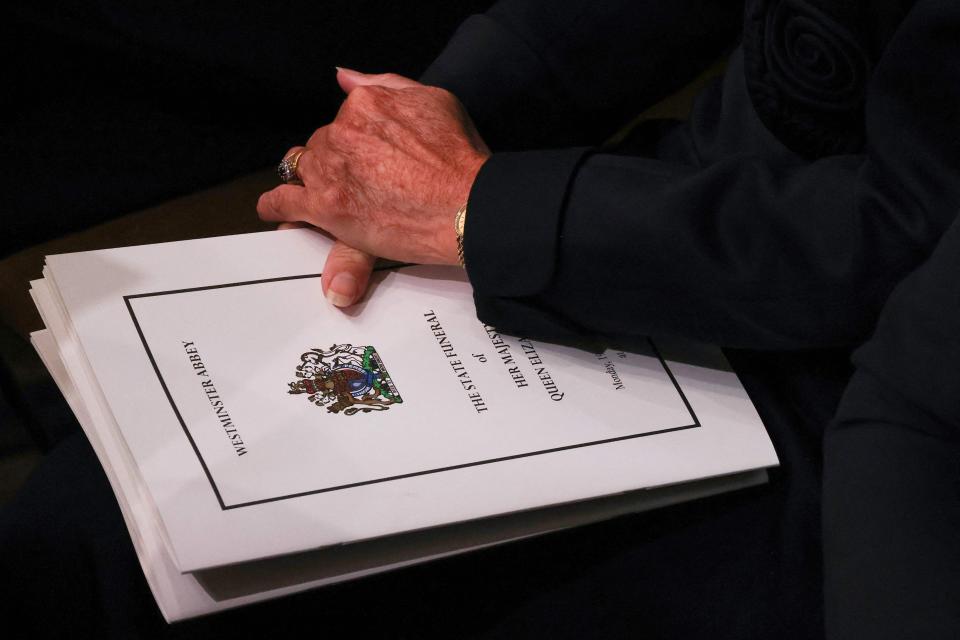
Details about Queen Elizabeth's coffin
The oak coffin was made more than 30 years ago, funeral directors previously confirmed to USA TODAY. Leverton & Sons, which has served as funeral directors to the royal household said it inherited the coffin made for the queen by another firm, Kenyons.
Andrew Leverton, a funeral director at Leverton & Sons, previously told British outlet the Times "It is made from English oak, which is very difficult to get hold of.
“Oak coffins are now made from American oak. I don’t think we could use English oak for a coffin now. It would be too expensive,” he told the outlet.
The coffin is also lined with lead, Leverton & Sons said. The lead lining makes the coffin so heavy that eight military bearers carried it Monday.
Queen Elizabeth II's casket: Queen to be buried in decades-old coffin lined with lead that takes 8 people to carry
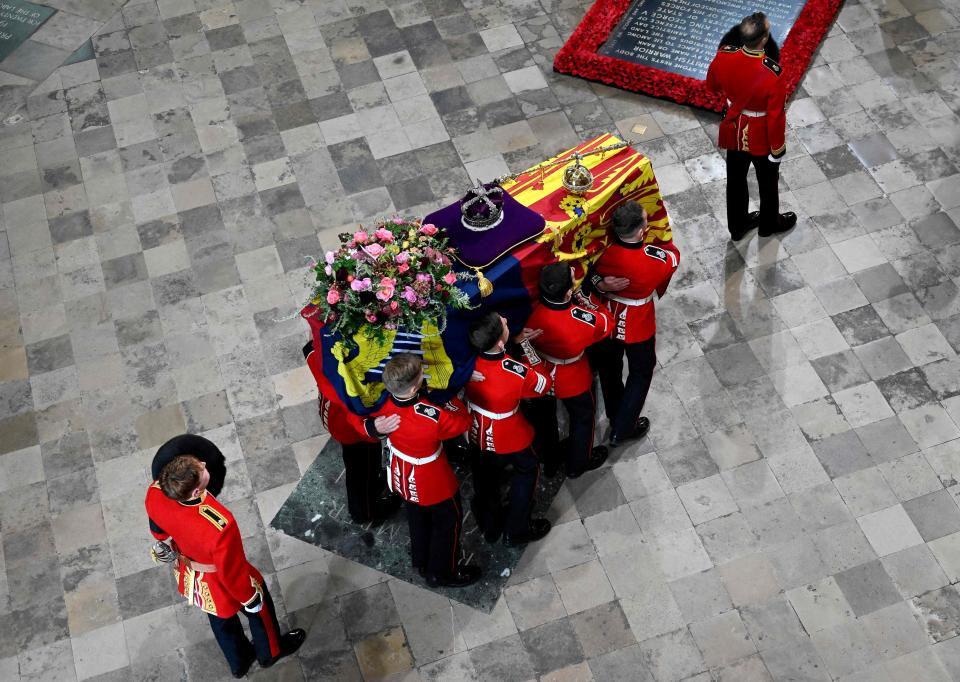
Imperial State Crown: Details about crown atop casket
The majestic Imperial State Crown sits atop the queen’s flag-draped coffin as the queen was moved to Westminster Abbey, along with her scepter and orb.
The crown, the same one the young Queen Elizabeth II wore for her coronation in 1953, is adorned with stones including the 317-carat Cullinan II diamond, one of several stones cut from the more than 3,000-carat Cullinan Diamond, mined in South Africa in 1905, when the nation was a British colony. The main stone – the 530.2-carat Cullinan I diamond, also called the Star of Africa – rests at the top of the monarch’s scepter.
As the royal jewels are in the news, so are repeated calls to return the diamonds to their country of origin. The queen's death at 96 on Sept. 8 has also renewed the conversation of the royal family's ties to colonialism and the queen's lack of apology or atonement.
Calls for reparation from former colonial powers are not new, but they have resurged in recent years. Barbados in November 2021 removed the queen as its head of state, becoming the region’s newest republic. Six other Caribbean countries have signaled their intent to follow suit.
The monarchy: Imperial State Crown and royal scepter glimmer, but some say on back of colonialism
What is the gun carriage used to carry the queen?
When the coffin emerged from Westminster Hall, the pallbearers placed it on the green gun carriage that was used for the funerals of the queen’s father, grandfather and great-grandfather, all kings.
King Charles, Princess Anne, Prince Andrew and Prince Edward flanked the procession, followed by several other members of the royal family including Prince William and Prince Harry.
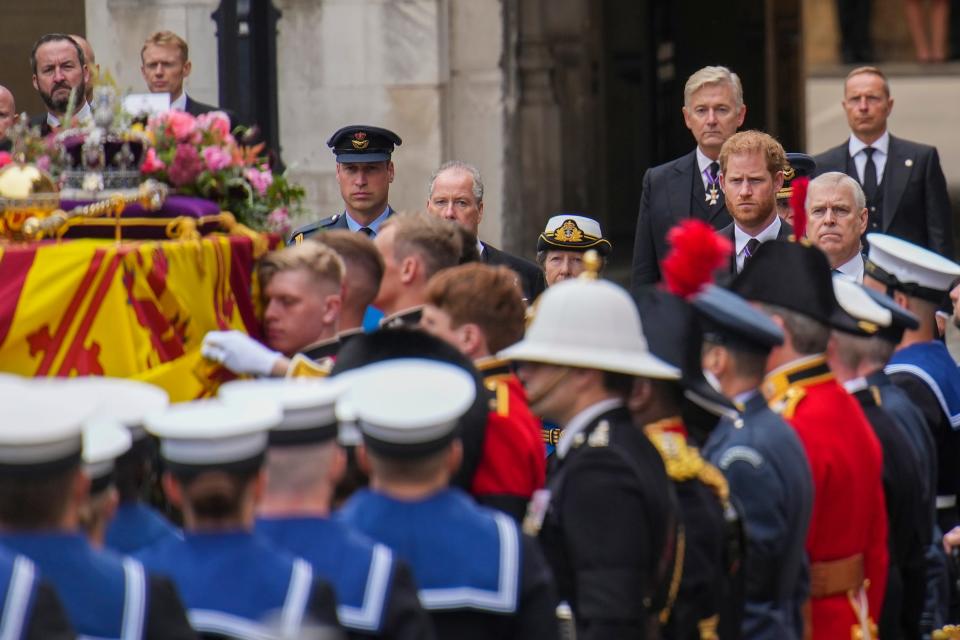
King Charles, more royals arrive at funeral
King Charles was met with applause by crowds as his motorcade arrived at Westminster Hall for the queen's coffin procession to Westminster Abbey. Prince William and Prince Harry joined him.
One car contained Queen Consort Camilla and Catherine, Princess of Wales, with her children, Prince George and Princess Charlotte. Another featured Meghan, Duchess of Sussex, and Sophie, Countess of Wessex.
More members of the royal family, including Prince William, Catherine, Princess of Wales, Prince Harry and Meghan, Duchess of Sussex, arrived shortly after.

The funeral’s order of service showed that George and Charlotte will walk together behind their parents. They will be followed by Prince Harry and his wife Meghan, the Duchess of Sussex, and other royal family members.
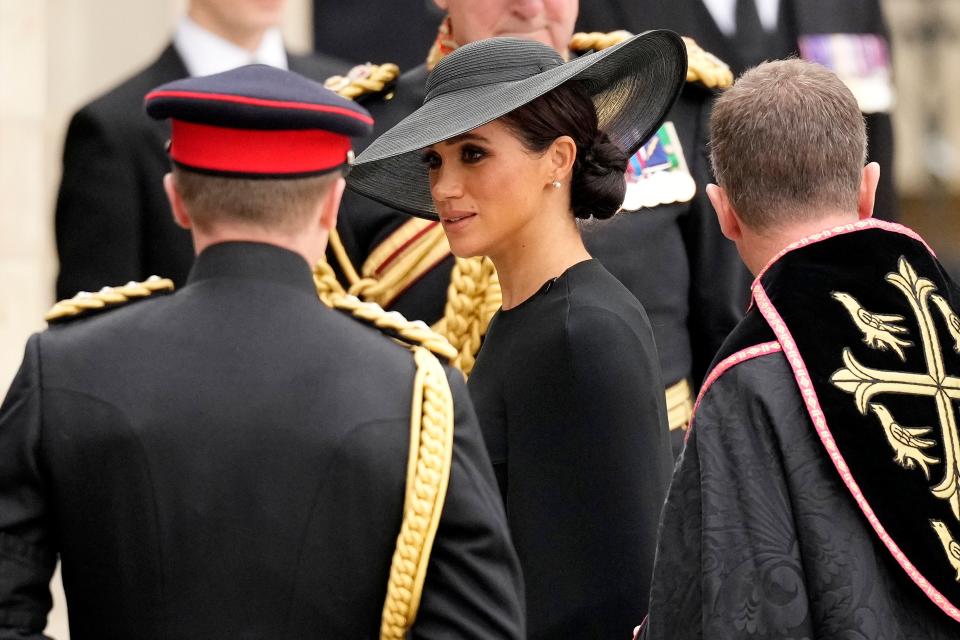
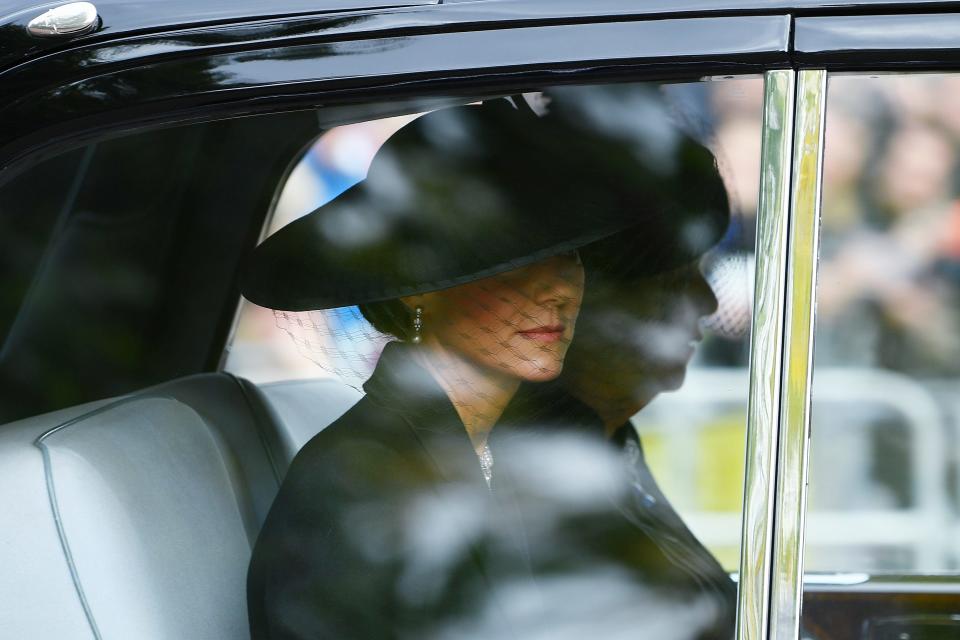
The royal children’s 4-year-old brother, Prince Louis, is not expected to be present at the funeral, which will be attended by some 2,000 people.
President Joe Biden, Prime Minister Liz Truss, more world leaders arrive
U.S. President Joe Biden, accompanied by first lady Jill Biden, is among the top world leaders who arrived at Westminster Abbey ahead of the funeral.
Biden arrived at Westminster Abbey for the queen’s funeral in his armored limousine, The Beast. He was among the few international diplomats who, for security reasons, did not ride on a fleet of chartered luxury buses provided for other world leaders. Biden stepped out of the The Beast a few minutes after 10 a.m. local time. He did not say anything or address the press.
Biden arrives for #queensfuneral pic.twitter.com/eqB8e3si5q
— Kim Hjelmgaard (@khjelmgaard) September 19, 2022
Many other leaders arrived Monday morning via bus; the Bidens arrived separately. British Prime Minister Liz Truss and husband Hugh O'Leary, Canadian Prime Minister Justin Trudeau and wife Sophie Trudeau, French President Emmanuel Macron and wife Brigitte Macron, Brazilian President Jair Bolsonaro and wife Michelle Bolsonaro and Israeli President Isaac Herzog and wife Michal Herzog were also spotted arriving.
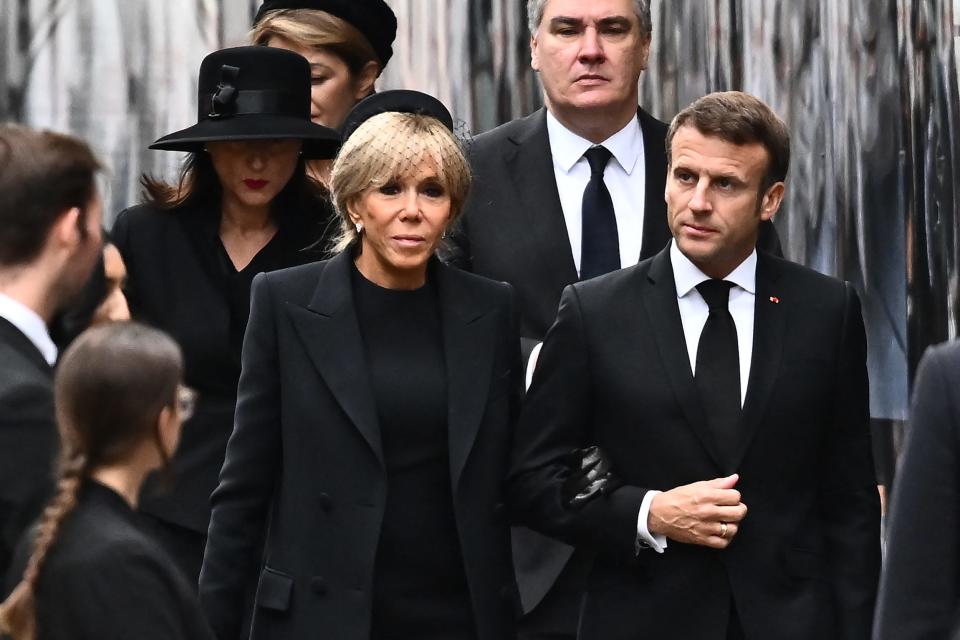
The president signed the official condolence book and attended a reception Sunday at Buckingham Palace hosted by King Charles III.
Biden is among many world leaders who traveled to the United Kingdom to honor Queen Elizabeth’s long reign. During his visit, Biden told media the queen "was the same in person as her image: decent, honorable and all about service."
"Our hearts go out to the royal family, King Charles and all of the family. It’s a loss that leaves a giant hole and sometimes you think you’ll never overcome it," the president said, adding that he told Charles the queen will be with him "every step of the way, every moment."
The day before the funeral: Biden arrives in London for funeral; Queen's grandchildren stand vigil by coffin
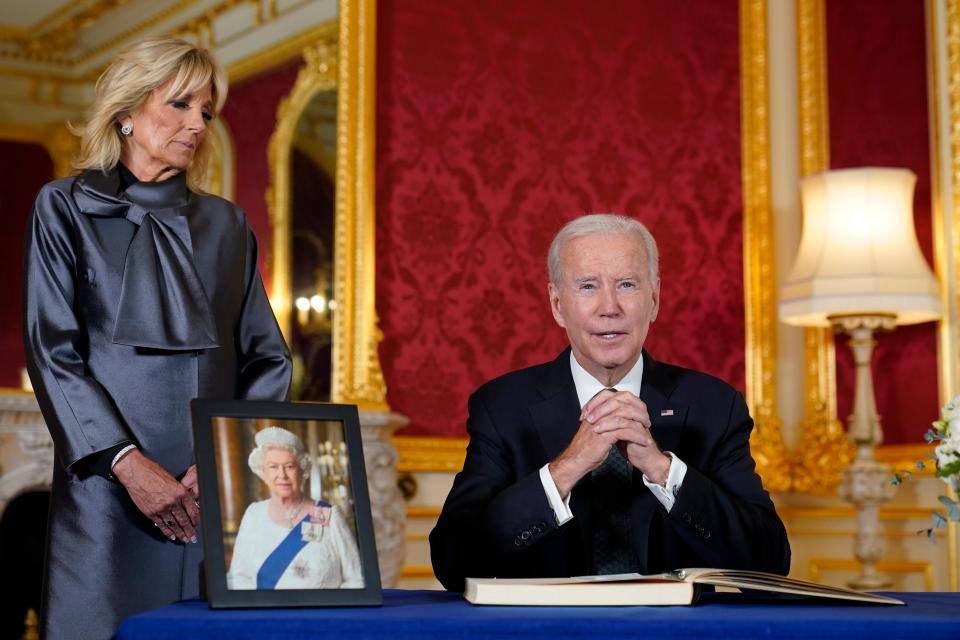
Tom Parker Bowles, more royals' family members arrive
Less than an hour and a half before the funeral is set to begin, notable arrivals connected to the royal family began to trickle in. Queen Consort Camilla's family was also photographed arriving at Westminster Abbey, including Laura Lopes, Camilla's 44-year-old daughter, and Tom Parker Bowles, her 47-year-old son. Princess Kate's parents, Carole and Michael Middleton, were also photographed upon arrival.
Camilla's new title, explained: What's the difference between queen and 'Queen Consort'?

Where will Queen Elizabeth II be buried?
The queen will be buried at St George Chapel at Windsor Castle, where many of her ancestors are buried, including her parents, King George VI and his consort, Queen Elizabeth, later the Queen Mother.
Following the funeral at Westminster Abbey, the coffin procession will begin, joined by King Charles, other members of the royal family, past and present members of the queen's household, governors general and prime ministers of the realms.
Queen Elizabeth II's funeral details: When is it? Will it be on TV? Your questions, answered
King Charles thanks the public for 'messages of condolence' ahead of queen's funeral
Ahead of Queen Elizabeth II's funeral, King Charles III issued a statement Sunday evening thanking people in Britain and across the world for "the many messages of condolence."
"Over the last ten days, my wife and I have been so deeply touched," the king said. "In London, Edinburgh, Hillsborough and Cardiff we were moved beyond measure by everyone who took the trouble to come and pay their respects to the lifelong service of my dear mother."
"As we all prepare to say our last farewell, I wanted simply to take this opportunity to say thank you to all those countless people who have been such a support and comfort to my family and myself in this time of grief," Charles concluded his statement.
Ahead of the queen's funeral Monday, a new photograph was released Sunday.
According to the royal family on Facebook, the photo was taken to mark the queen's Platinum Jubilee earlier this year. She was the first British monarch to reach this milestone.
"Tomorrow, millions will come together to commemorate her remarkable life," the post read.
Prince Charles is now King Charles III. Here's what to know about UK's new monarch.
How old is Westminster Abbey, site of Queen Elizabeth funeral?
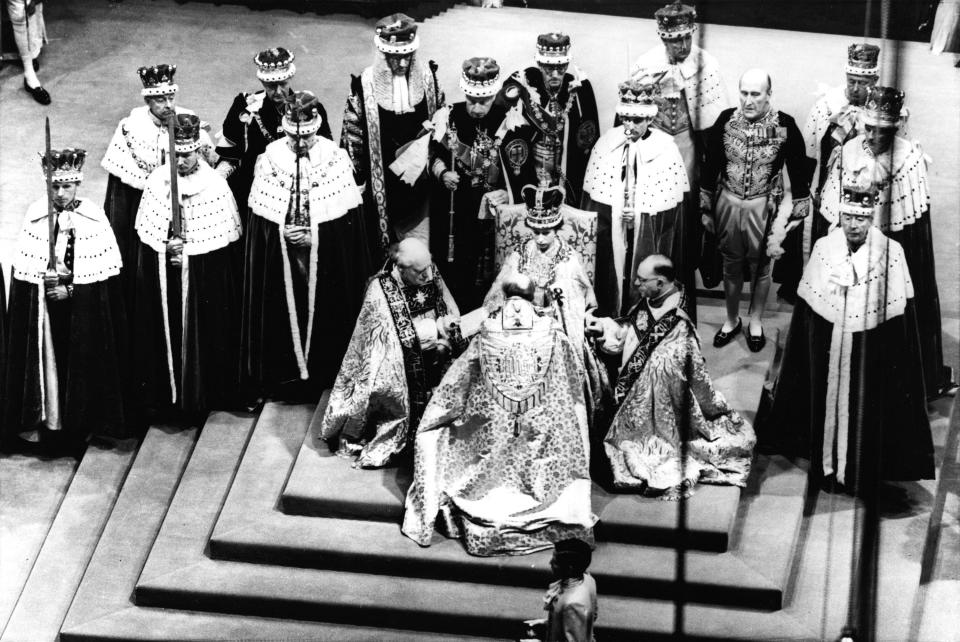
Westminster Abbey, where Queen Elizabeth II’s funeral will be held Monday, has a centuries-long association with the royal family, hosting generations of coronations, royal weddings and funerals.
The church, which was consecrated in 1065 and “has been the setting for every coronation since 1066” and 16 royal weddings, a statement on the abbey’s website says.
“Her Majesty Queen Elizabeth II's connection with Westminster Abbey ran like a thread through her early life and her long reign,” the site says. “As an 11-year-old girl, she watched as her father was crowned here. As a young adult, she married here and was crowned here.”
Fourteen English monarchs were buried there between 1066 and 1760, including Queen Elizabeth I, the daughter of King Henry VIII, who was interred in the abbey in 1603. The Unknown Warrior, whose body was brought from France in 1920, is buried in the abbey’s nave. Author Charles Dickens is among those buried in Poets' Corner of the abbey.
The funeral of Princess Diana was held at the abbey in 1997 and the Queen Mother’s funeral took place there in 2002. More recently, Prince William and Duchess Kate, now the Prince and Princess of Wales, were married there in 2011.
Visual guide to the funeral of Queen Elizabeth II at Westminster Abbey
Queen's funeral more than ceremony, designed to show monarchy's stability
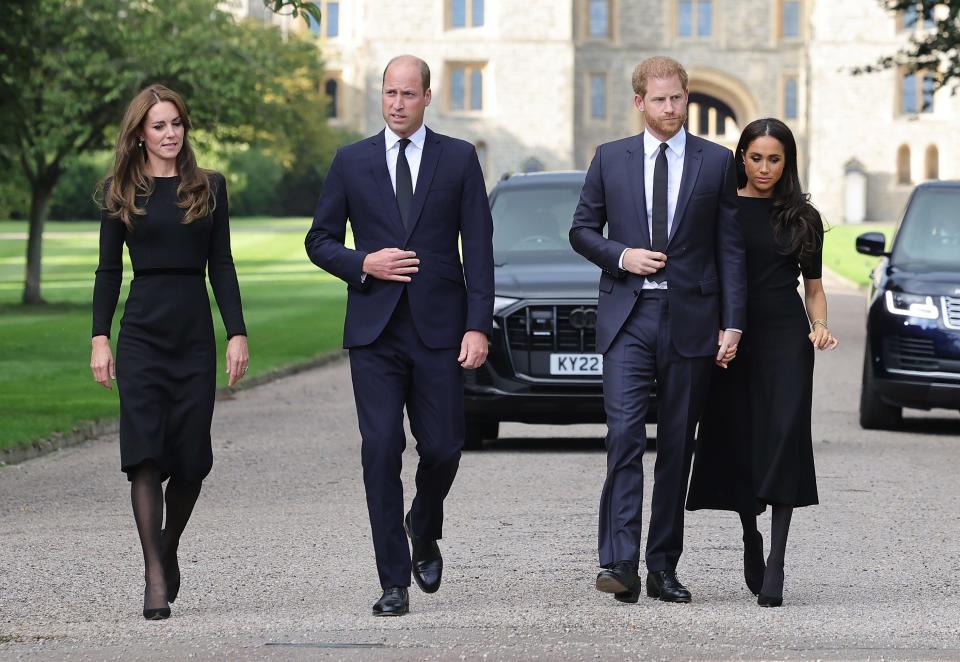
The queen, who died Sept. 8 in Scotland at age 96 after 70 years on the throne, was widely considered the glue holding the U.K. together. She was also the most canny of her Windsor ancestors about using ceremony and splendor to bond the monarchy and the people who pay for it.
Not since 1965, for former Prime Minister Winston Churchill, has Britain mounted a state funeral, which is usually reserved for monarchs, with exceptions for distinguished figures such as Churchill, the queen's first prime minister of her reign.
Royal funerals are planned decades in advance by governments and the crown, and the plans are updated regularly. The monarch plays a crucial role in deciding details. The choice of flowers in the wreath on her coffin, the music and prayer selections, even the bespoke design of the Royal Hearse (lots of glass and inside light so the casket can be seen even at night), were all decisions made by the queen.
Survival of the monarchy: Why Queen Elizabeth II's funeral is more than just ceremony
Mourners line the streets during queen's funeral
At 6 a.m. local time, snipers were on rooftops, sniffer dogs were on the streets, drains were being searched and surveillance drones have been banned from all of central London. Around 20 miles of barriers have been erected to control crowds as the queen’s coffin travels the short distance from Westminster Hall, where it is lying-in-state, to Westminster Abbey, and then onward to Windsor Castle after the funeral for burial.
A full five hours before the funeral gets underway, London’s transportation network was already busy on a public holiday, with the subway system seeing members of the public rushing to secure viewing spots in and around Buckingham Palace and the Palace of Westminster. Many carried small fold-up chairs, and Londoners almost entirely wore black in the quiet of the city. Volunteers in purple vests every few yards provided help with directions and other needs.
Hyde Park, one of London's central parks, is a designated screening spot for Queen Elizabeth II's state funeral on Monday. The 11 a.m.-ceremony will be broadcast live on large screens for attendees to see for free at the park, and the Hyde Park site will show the procession through London following the funeral, the procession through Windsor and the Committal Service at St George’s Chapel at Windsor Castle.
Signs and staff are present across the city to direct people to either the park or other "viewing areas" where they may catch a real glimpse of the state funeral route. The park and viewing areas include dedicated spots for anyone who has an accessibility need, including British Sign Language interpreters and a dedicated location for wheelchair users.
People watched the funeral and procession from almost everywhere – lining the streets 10-deep to sitting on blankets in parks.
Lucy Hartnell, 26, from Hertfordshire, organized a picnic at Hyde Park of what she and friends assumed were “queen favorites” including strawberries, cucumber finger sandwiches, Prosecco, cupcakes and chips. They took the tube into London and were "shocked" how easy it was for them to get to Hyde Park to view the funeral.
They said they attended to not miss a big event and aren’t really pro-royal or anti-royal, which has been a large debate among young people.
"We’re not super against the royals or for them, we just wanted to be part of them moment," Hartnell said.
They said the transition to a king likely won’t affect them, but they said the area where they grew up is very pro-monarchy. "Our grandparents care a lot. We don’t care that much either way. People our age are like 'we should get rid of the monarchy.' But no one cares enough to actually do anything about it … we just like having them," she said.
Contributing: Nicole Fallert, Kim Hjelmgaard, Jane Onyanga-Omara, Maria Puente, Laura Trujillo, Amy Haneline and Morgan Hines, USA TODAY; Associated Press
This article originally appeared on USA TODAY: Queen funeral updates: Elizabeth laid to rest alongside Prince Philip
